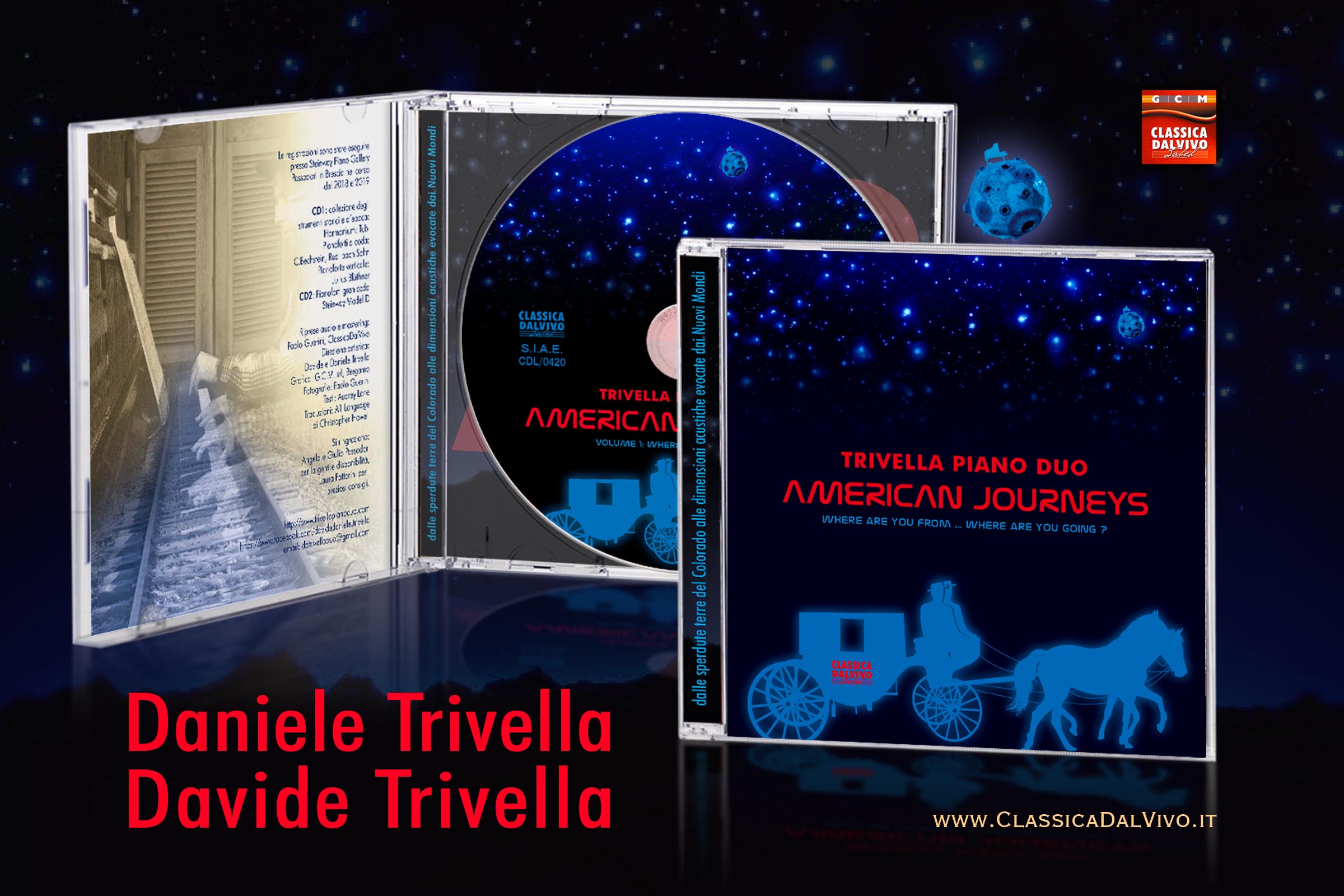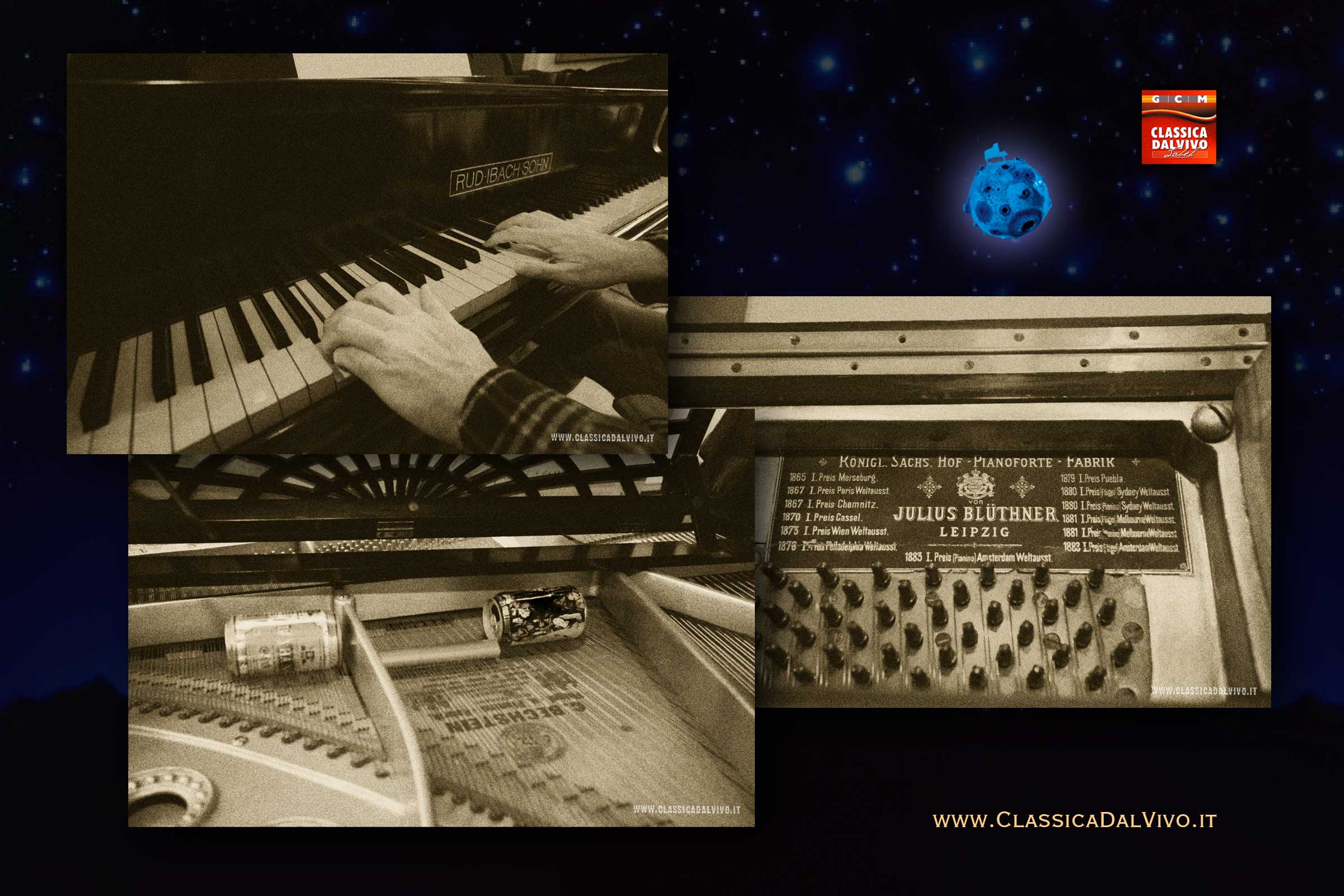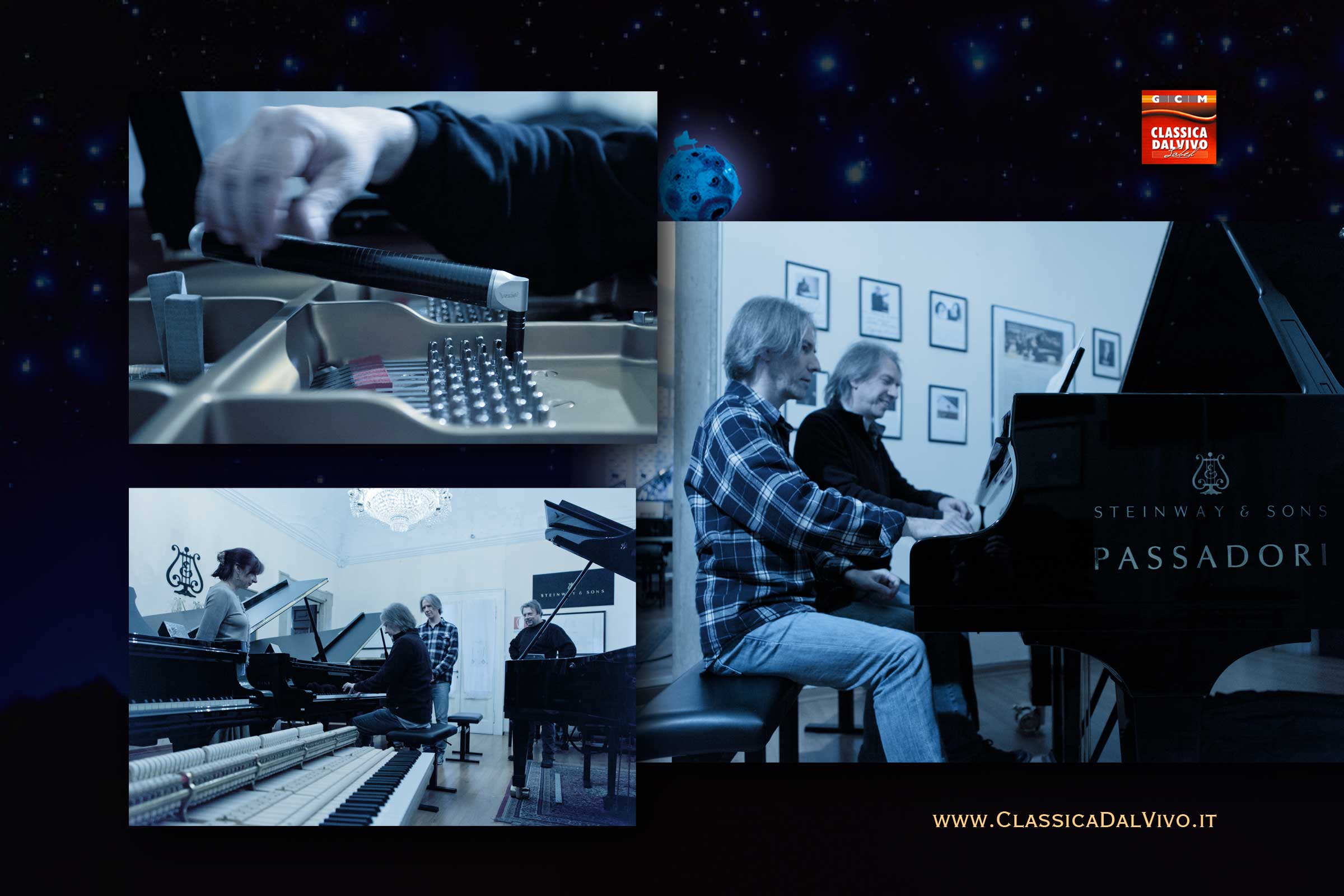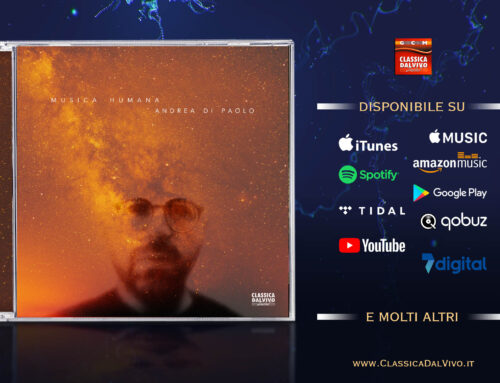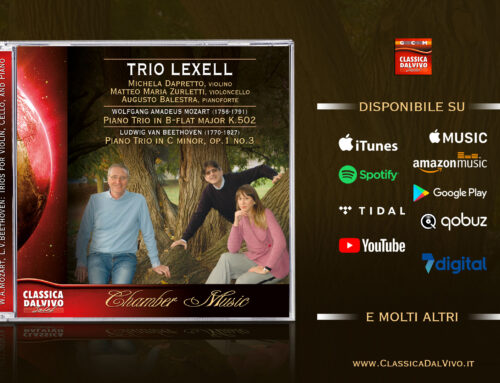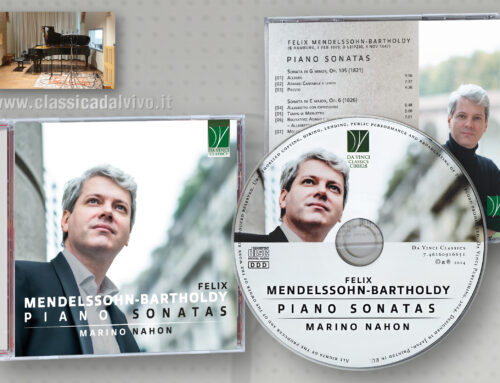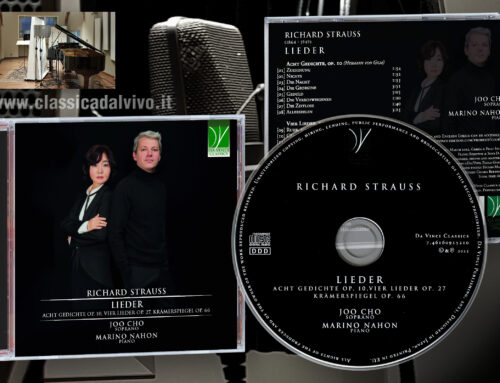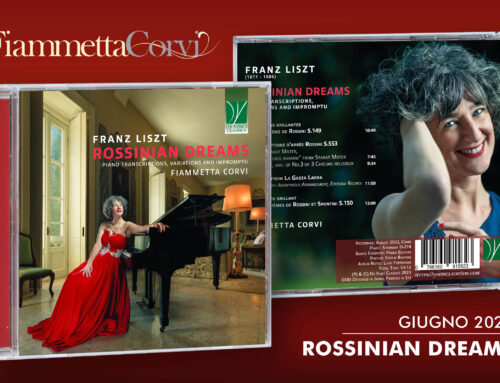Descrizione Progetto
Trivella Piano Duo: American Journeys
Where are you from ? … Where are you going ?
Nel vecchio west il “tenere gli occhi ben aperti” non era un detto ma un obbligo di fatto per trovare una minima sopravvivenza.
Nel viaggio che vi proponiamo noi come “visto” vi consigliamo invece di tenerli ben chiusi gli occhi, ma non fino ad addormentarvi altrimenti noi non ci assumeremo troppo questa responsabilità, e di lasciarvi abbandonare alle sensazioni che più vi ispireranno le immagini sonore: questo nostro vagabondare dalle sperdute terre del Colorado alle colorate anzi, coloratissime dimensioni acustiche evocate da “Nuovi Mondi” non ancora esplorati e sempre in espansione sono, a parer nostro, all’origine del Viaggio più spettacolare, meraviglioso e avventuroso, quello dentro di noi.
In the old Far West, “keeping your eyes skinned” was not just a saying. It was an unwritten law if you reckoned on surviving.
In the trip we offer here as a “vision”*, we suggest you keep your eyes firmly shut. Without going to sleep – we decline all responsibility if you do that. Just let yourselves go. Drink in the sensations the sound images awaken in you. The images of our wanderings from the godforsaken lands of the Colorado to the colored – highly colored – sonorous dimensions evoked by “New Worlds”. Worlds that are unexplored and growing all the time. Worlds that we believe to be at the origin of the most spectacular, marvelous and adventurous journey of all. The journey inside ourselves.
Daniele e Davide Trivella
* The Italian word “visto” means both “vision” and the “visa” stamp on a passport.
Il video di anticipazione del disco, il sottofondo musicale è la traccia 16 The Riddle del CD 1 .
Video di presentazione del disco. Il sottofondo è un estratto della traccia di apertura del CD: She’s Like the Swallow
Per maggiori informazioni, cliccare sul pulsante sottostante per scaricare il booklet del CD in formato pdf.
Volume 1: Where are you from ? …
Immaginiamo una piccola cittadina nel lontano West a cavallo tra ‘800 e ‘900.
Viene organizzato, per commemorare un particolare evento, un concerto aperto alla cittadinanza costituita prevalentemente da allevatori, minatori, o comunque da gente che non ha mai potuto accedere alla musica “colta”.
Si trovano a passare di lì due pianisti che hanno studiato nel Vecchio Continente, ai quali viene chiesto di improvvisare sui temi e sulle musiche che la popolazione conosce.
Si cercano nella cittadina i pochi strumenti disponibili: l’armonium della chiesa (in qualche modo ancora funzionante), il pianoforte verticale del saloon (assai scordato) e il pianoforte a coda (a dire il vero, i cui tasti mai sono stati sfiorati da un pianista!) che fa bella mostra di sé nel salotto della famiglia più in vista del paese.
Viene deciso che il concerto si terrà nel saloon dove, durante l’esibizione, accade un po’ di tutto: come da tradizione viene chiesto agli ascoltatori di lasciare le armi all’ingresso, ma poi… “non sparate sul pianista”… e una tradizionale rissa da saloon: sedie volanti, qualche bottiglia cade nel pianoforte (ed ora lasciamo alla vostra immaginazione il risultato!), in più arriva un temporale che guasta per un attimo la festa, ma poi le rondini… tornano a garrire e il sole riappare!
Infine, forse, i pianisti ci faranno ascoltare, a loro modo, qualche brano che hanno “appreso” nella lontana Europa.
Tutte queste cose sono accadute realmente durante la registrazione, eseguita su strumenti dell’epoca dei quali abbiamo documentato anche tutti gli acciacchi ed i cigolii, messi gentilmente a disposizione e preparati da Giulio Passadori.
Forse questa registrazione resterà un ricordo per noi e per i nostri nipotini, forse verrà distribuita in tiratura limitatissima ai nostri più cari amici, forse verrà pubblicata… non si sa mai!
Per ora abbiamo il ricordo e qualche foto di questa splendida giornata trascorsa
insieme a far liberamente musica!
Hasta la vista!
Let’s see in our minds a small town in the Far West at the turn of the 19th century.
There’s a special event to celebrate, and they’re putting on a concert for a town population that consists mainly of cattle breeders, miners and others who have never had the chance to hear “serious” music.
It so happens that two pianists are passing that way who have studied on the Old Continent. They’ve been asked to improvise on tunes and music that the people know.
The town is scoured for the few instruments on offer. There’s the church harmonium (still working up to a point) and a vertical piano, way out of tune, in the saloon bar. While in the parlor of the leading family of the town there’s a good-looking grand, though, truth to tell, no pianist has ever tinkled its ivories.
It’s been decided to hold the concert in the saloon. While it’s taking place, just about everything imaginable happens. In line with tradition, listeners are asked to leave their guns at the door … “don’t shoot the pianist”.
Even so, there’s the odd fisticuff, chairs fly freely and a few bottles end up in the piano (we’ll let you imagine what that sounds like!). What’s more, a thunderstorm arrives to put a wet blanket on the proceedings, but it’s soon over, the swallows start twittering and the sun is out again!
All these things really happened during the recording, which was made with period instruments whit some related noises and crunches, kindly lent and prepared by Giulio Passadori.
We hope you’ll find this recording as much fun to listen to as we did to make it!
Hasta la vista!
Daniele & Davide Trivella: Improvisations on american traditional songs:
She’s like the Swallow, The Colorado Trail, I’d like to be, Devil’s Dream, She’ll be coming, Song of the Seashore, Campton race, Frankie, Fly around, Oh my darling, Improvvisation, Jesse James, El entrerriano, El Panete, Guantanamera, CC Rider, Streets of Laredo, Shenandoah, Pig Town, Down By the Bay, Blue Tail Fly, Bill Bailey, The Riddle, Rio Grande, Old Folks blues, Old McDonald, Once I had, She’s like the Swallow for prepared pianos.
Volume 2: … Where are you Going ?
[1] John Adams (1947): Hallelujah Junction (1996)
Il nome deriva da una piccola fermata di camion sulla US 395 che incontra l’alternativa US 40, vicino al confine tra California e Nevada. Adams ha detto del pezzo: “Qui abbiamo un caso di un grande titolo in cerca di un pezzo. Quindi ora il pezzo esiste finalmente: la “giunzione” è lo stile ad incastro della scrittura a due piani che presenta brevi motivi altamente ritmati che rimbalzano avanti e indietro tra i due pianoforti in sequenze strettamente fuse”.
Il lavoro ruota attorno alla ripetizione ritardata tra i due pianoforti, creando un effetto di echi sonori. Vi è uno spostamento costante di impulso e metro, ma i ritmi principali si basano sui ritmi della parola “Hal – le – LU – jah”.
The name comes from a small truck stop on US 395 which meets Alternate US 40, near the California–Nevada border. Adams said of the piece, “Here we have a case of a great title looking for a piece. So now the piece finally exists: the ‘junction’ being the interlocking style of two-piano writing which features short, highly rhythmicized motives bouncing back and forth between the two pianos in tightly phased sequences”.
The work centers around delayed repetition between the two pianos, creating an effect of echoing sonorities. There is a constant shift of pulse and meter, but the main rhythms are based on the rhythms of the word “Hal–le–LU–jah”.
[2-5] Lowell Liebermann (1961): Sonata Op. 117 (2011)
La sonata per due pianoforti 0p.117 (2011) è stata commissionata dal Washington State College of Liberal Arts e dalla School of Music Artist Trust, dalla National Federation of Music Clubs e dalla Washington State Music Teachers Association.
Il lavoro è in quattro movimenti. L’apertura di Lento è in una forma ad arco. Il secondo movimento combina scherzo e elementi simili a una marcia, con un’introduzione che si ripete palindromicamente alla fine. Segue un altro movimento Lento e il lavoro si chiude con un allenamento contrappuntistico virtuosistico per i due pianisti, il finale, da suonare “il più velocemente possibile”.
La sonata per due pianoforti 0p.117 (2011) è stata commissionata dal Washington State College of Liberal Arts e dalla School of Music Artist Trust, dalla National Federation of Music Clubs e dalla Washington State Music Teachers Association.
Il lavoro è in quattro movimenti. L’apertura di Lento è in una forma ad arco. Il secondo movimento combina scherzo e elementi simili a una marcia, con un’introduzione che si ripete palindromicamente alla fine. Segue un altro movimento Lento e il lavoro si chiude con un allenamento contrappuntistico virtuosistico per i due pianisti, il finale, da suonare “il più velocemente possibile”.
[6-9] Alice Ping Yee Ho (1961): Glistening Pianos (2009)
Questo lavoro si ispira alle strofe di apertura di una poesia del poeta britannico Lord G. Gordon Byron:
“Cammina nella bellezza, come la notte / Di climi senza nuvole e cieli stellati”.
Il poeta incontra l’oggetto del suo affetto durante il lutto per la morte di una persona cara, e la poesia è stata scritta come celebrazione della bellezza di questo soggetto. In questo lavoro i due pianoforti simboleggiano le due forze enunciate nella poesia: luce e oscurità, la bellezza interiore e la bellezza esteriore della donna. Il titolo “Pianoforti Scintillanti” spiega la profondità della bellezza di questa donna, anche nell’oscurità della morte e del lutto, la sua bellezza traspare.
This work is inspired by the opening lines of a poem by British poet Lord G. Gordon Byron: “She walks in beauty, like the night/Of cloudless climes and starry skies”. The poet met his object of affection for the first time while she was in mourning over the death of a loved one, and the poem was created as a celebration of the subject’s beauty. In this work the two pianos are symbolic of the two pronounced forces involved in the poetry: light and darkness, also the two areas of a woman’s beauty- the internal and the external. The title “Glistening Pianos” explains the depth of this woman’s’ beauty, even in the darkness of death and mourning, her beauty shines through.
The composition unfolds in four stages: an introduction followed by three connected movements, and the music evolves from quiet lyricism to blazing energy.
Il disco è disponibile per l’ascolto in streaming su Spotify (cliccare per collegarsi a Spotify) e per l’acquisto su iTunes o su AmazonMp3, oltre anumerose altre piattaforme, anche ad alta definizione.
Non appena possibile, il CD doppio sarà disponibile anche nella versione “fisica” presso gli artisti e sul sito ClassicaDalVivo.

